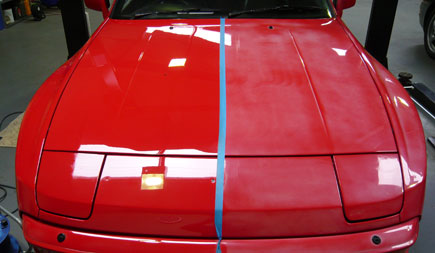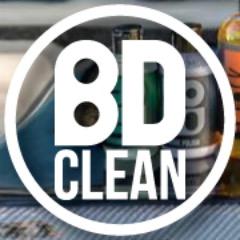What is oxidation
Written by: Vinnie van Rooij
Oxidation is the chemical process in which there is a chemical reaction that involves the moving of electrons. To be more precise, it means that the substance that is giving away electrons is oxidized. In simple terms it means that the surface of any object is affected when time goes by.
Contents
Oxidation in the field of detailing
Basically, any object can oxidize. Cars, motorcycles and any other vehicle that is exposed to air.
Wikipedia’s text about oxygen:
Oxygen is a chemical element with symbol O and atomic number 8. It is a member of the chalcogen group on the periodic table and is a highly reactive nonmetal and oxidizing agent that readily forms compounds (notably oxides) with most elements.
Oxygen causes oxidation, even though it is in relative small terms, it still affects any element in comes into contact with. For a detailer this means that any surface eventually shows signs of oxidation. This could mean that a certain metal will start to show surface imperfections even though it doesn’t get dirty, or comes into contact with anything else then air. This also means that paintwork oxidizes. The surface of the paintwork will change very slightly in molecular structure.
It is this oxidation that needs to be removed to show the glossy finish underneath. Removing the surface oxidation will help protective products such as wax, sealants and coatings to bond better with the surface.
How to remove oxidation
This is actually one of the easier processes. Most surface imperfections are causes by a big difference in the microscopic unevenness of a surface. If the difference is big enough, we start to call it an imperfection or even a scratch or RDS.
Oxidation can be removed by 2 different processes:
- Claying (which will remove a fair bit, but not all)
- Polishing (if done correctly, it will remove most of not all)
- Chemical removal (in very rare cases, a chemical can remove or temporarily stop the oxidation process)
What types of oxidation will you encounter while detailing?
There are several forms of oxidation you might encounter while detailing, and some are easier to remove then others.
- Surface oxidation on paint work – fairly easy to remove by claying and polishing. Reveals a surface with more shine (increased surface refractive index)
- Surface oxidation on glass – more effort to remove by polishing glass with a proper glass polish. Only results might be that wiper-marks are slightly less visible and improved water behavior
- Fallout – easily removed by a fallout remover
- Surface rust – such as the one on your brake discs, can be removed by polishing
- Surface breakdown – can not be removed, it is simply a degradation and disintegration of an object
- Rubber vulcanization – can not be removed, using a dressing will hide it a bit
Why would you want to remove oxidation
Oxidation causes the microscopic surface to chance structure, the smooth flat and highly refractive surface changes into a matte surface with a low refractive index. Simply put: less shiny. Also, when oxidation is treated quickly enough, it will prevent spreading out to more sensitive areas and complete disintegration will be prevented.
When iron oxide comes into play, it can cause a brown/orangy haze over the surface. Which might negatively affect the look of the object.
In general you can conclude that removing oxidation improves aesthetic appeal and depending on the form and material it can be of benefit for future maintenance and/or longevity.
Faded red or blue paintwork and how to fix it
You often see older cars with very matte looking paint. The original look of the car has negatively changed and the paint has faded badly. The most common color to notice this effect is red, but there are many examples of yellow, blue, green and white cars that show the same fading. Although it is commonly said that red fades the most, there are no statistics that support this claim. However, according to research from DuPont, the color red was the most popular color besides white, black and silver/grey. Which would explain why there simply are more red cars that suffer from paintwork fading (= surface oxidation).
This happens mainly to cars that have no clear coat. The “unprotected” colored layer of paint reacts differently to light and oxygen which shows the effects of oxidation more then a clear coat. Luckily, the effects are fairly easy to fix. A good clay and a 2 stage polish will in most cases be enough to bring back the shine of the paintwork.

Although paintwork without a clear coat will oxidize a lot quicker, and show it’s effects sooner, paintwork with clear coat can also oxidize. Very dirty paintwork that is exposed to many different forms of contaminants can actually oxidize slightly quicker as its surface is effectively bigger. The many microscopic hills and valleys actually increase the effective surface.
Can you prevent oxidation?
Yes you can. Certain protective products seal in the surface well enough to prevent it from oxidizing. A layer of wax will oxidize more then the surface underneath, but it will not last forever because the layer of wax will disintegrate over time. A sealant might offer more protection against oxidation because it uses different ingredients that are less prone to disintegration and deterioration. Ceramic coatings might offer more protection seeing as their hard and tough nature. These last 2 protective products will also have more effect on UV than wax.
The downside of these products is that they are all temporary. To use a more permanent solution, the surface needs an extensive polishing to remove any form of oxidation and then a total respray with a clear coat. This would be a much more permanent solution, but also a more expensive one.
Washing the surface with suitable products will also help. Household cleaning products often contain Citric Acid, which can actually start or push a form of surface oxidation that will eventually result in a very dull look.
Different related articles
 Detail King is an American manufacturer and supplier of automotive detailing products. The company offers products, trainings, classes, and authorizes detailers to use their products....
Detail King is an American manufacturer and supplier of automotive detailing products. The company offers products, trainings, classes, and authorizes detailers to use their products.... BD Clean is a brand of detailing products based in Birmingham, United Kingdom. The logo used by the brand resembles a smiley and is used in the labels for each product. The brand has made a reputation that they are very approachable and friendly....
BD Clean is a brand of detailing products based in Birmingham, United Kingdom. The logo used by the brand resembles a smiley and is used in the labels for each product. The brand has made a reputation that they are very approachable and friendly.... Zymöl is a manufacturer of different car care product and is located in America. The history and links with the Swissvax company has caused for some problems in the past. Zymöl products are generally aimed at varies parts of the detailing process....
Zymöl is a manufacturer of different car care product and is located in America. The history and links with the Swissvax company has caused for some problems in the past. Zymöl products are generally aimed at varies parts of the detailing process.... 303 is an American brand by GoldEagle and consists of several detailing products for a wide variety of markets. The products can be used for automotive detailing, but also for indoor/outdoor use and boat care. The brand offers several different products for several different tasks....
303 is an American brand by GoldEagle and consists of several detailing products for a wide variety of markets. The products can be used for automotive detailing, but also for indoor/outdoor use and boat care. The brand offers several different products for several different tasks.... Polishing is the act of using a light abrasive product to remove a very thin layer from the surface that gets polished. Usually this process is preceded by a very thorough cleaning of the surface....
Polishing is the act of using a light abrasive product to remove a very thin layer from the surface that gets polished. Usually this process is preceded by a very thorough cleaning of the surface.... It is often asked on detailing fora and social media: "what is the best claybar or claymitt". Off course there is a difference between certain products and brands, but it is important to know what you are asking. In this guide I will try to explain what the problem is with this question unless it is asked more in-depth....
It is often asked on detailing fora and social media: "what is the best claybar or claymitt". Off course there is a difference between certain products and brands, but it is important to know what you are asking. In this guide I will try to explain what the problem is with this question unless it is asked more in-depth....







Links to this article
There are no external links to this article. Yet.